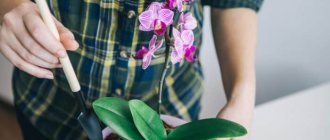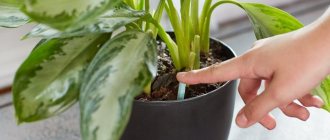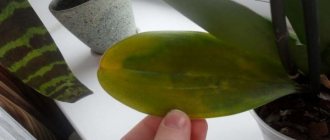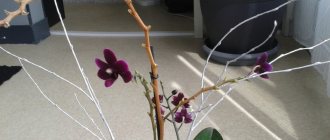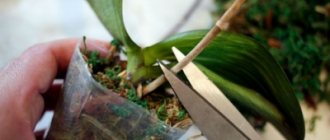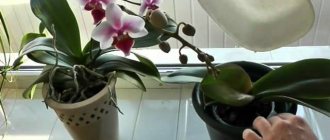Orchids are characterized by strong adaptability and due to this, in most cases they turn out to be hardy and not too capricious plants.
However, systematic violation of normal maintenance conditions, errors in care and negligence can cause loss of decorativeness, the appearance of pests, disease and even death of the plant.
Below you can read about the main diseases and problems with leaves (photos and videos will help you determine the diagnosis).
What causes burns?
Burns may appear due to a change in place of residence, for example, when their store moves to your home or changes location within an apartment. In this case, the plant, not accustomed to intense lighting, figuratively chokes on the light and gets burned. In the spring-summer period, with increasing sun activity, the orchid can also get burned, and even a short stay of the plant in direct sunlight is enough. Also, spots can appear due to the so-called heat stroke, with poor air ventilation. To prevent burns on orchid leaves, it is necessary to protect them from the midday sun, monitor whether the plant is overheating, since hot leaves are easily damaged by sunlight, provide a flow of fresh air and a sufficient amount of water. It should be remembered that phalaenopsis, miltonia, cumbria and lady's slippers with delicate leaves easily overheat, while cattleyas, dendrobiums, oncidiums and cymbidiums need bright sunlight to set flower stalks.
Main diseases of orchid leaves and treatment methods
In monopodial orchids, the main storage organ is the leaves. This is where the plant stores water, energy and nutrients. Thus, any problems with the leaves indicate a more serious problem than it might seem at first glance.
Turn yellow
Most often this happens due to insufficient watering and keeping the plant too dry. Also, the cause may be too bright lighting, leading to burns, an excess of nutrients, or certain problems with the root system.
Often the leaves turn yellow due to lack of moisture.
Read more about why orchid leaves turn yellow in this article.
Wither
At high ( more than 27-28 ° C ) temperatures, tropical orchids experience shock and begin to actively evaporate moisture in an attempt to cool down. Thus, the leaves lose turgor, wrinkle and look lethargic. Lack of watering and moisture also applies to this.
Somewhat less commonly, the cause of wilt may be a disease , for example, bacterial soft rot or tracheomycosis wilt.
Read more about why leaves wither here.
Stains
They are a symptom of a disease or pest infestation . First, it is necessary to determine the nature of the spots in order to accurately diagnose and make recommendations. Because it could be:
- black bacterial spot;
- Alternaria blight;
- moniliosis;
- burns;
- bacterial cancer and many others.
Attention! Obviously, for proper treatment, it is first necessary to establish the root cause of the present situation. And only then begin active actions. Improper use of any drugs for treatment can lead to serious complications.
You will learn all the information about all the reasons for the appearance of spots from this article.
What does sunburn look like on an orchid?
As a rule, the leaves or neck of the orchid are damaged. Burns appear as various spots. There are two types.
- Dry spots of light color with or without an outline.
- Heterogeneous weeping spots.
I’ll note right away that the first option is better for you, such spots rarely grow and spread, and if you shade the orchid, then the orchid and you will get off with a slight fright - the plant will simply dry out the damaged leaf over time.
Dry sunburn on a dendrobium leaf
With wet spots it is a little more difficult, a bacterial infection can develop there and the spots will begin to grow, eating the plant.
weeping sunburn spot
Heat
The most comfortable temperature for orchids is considered to be 18-25 degrees, but in summer it sometimes rises to 35 degrees or more. If this increase is short-term, then the plants can tolerate it, but prolonged heat can weaken the immunity of orchids, which can lead to stunted growth or the development of diseases.
To help plants survive hot days, you need to move them from window sills and place them at a short distance from the window to provide diffused lighting. In order for orchids to feel comfortable in the summer, you need to monitor the temperature and humidity in the room. Using an air conditioner will have a good effect, but only on condition that the plant is located away from the flow of cold air.
In summer, you need to provide more frequent watering than at other times of the year, since moisture evaporates quickly. Do not let the soil become completely dry and leave the orchid there for several days. Watering should be done with soft water. It is necessary to maintain air humidity by periodically spraying the substrate or placing trays of water next to the pots.
The money tree pleases with lush flowering: my secret is in caring for the leaves
Women's jeans: before you buy them, you need to pay attention to one detail
“We are still friends”: Derevianko commented on the breakup with his wife
What to do if an orchid gets burned
After we remove the orchid from the sun, take a felt-tip pen or marker and draw lines along the boundaries of the spots. This way we can quickly notice and respond to their growth. If the damage does not spread, then everything will be fine and a little later it will be possible to cut the leaf to living tissue. Otherwise, I sprinkle the stain on the leaf with a crushed tablet of any antibiotic from a human pharmacy or baneocin. These measures prevent the development of a bacterial infection. If the spots are located on the neck, then our actions are the same as for rot, cut it out and wait for the baby.
This is written in detail in the articles:
How to save a phalaenopsis without a growing point and get a baby from it
How to recognize that the neck of a phalaenopsis is rotting and what to do about it?
How to fix the situation
Having determined the cause of your orchid’s malaise, try to correct your mistake in care, if possible. As a last resort, do not repeat it again.
If the plant overheats next to the radiator, move it deeper into the room, but create additional lighting.
If the root system becomes waterlogged, dry the roots and substrate. Do not water until the roots are well dried, this may take 2 weeks.
If burns appear, rearrange or shade the orchid. Damage resulting from burns or prolonged contact with water cannot be treated.
The leaves, unfortunately, will not be able to return to their previous appearance. They can be left if the damage is minor, or removed if they spoil the appearance of the orchid.
See: Orchid diseases: symptoms, photos, causes and treatment methods
Author: Irina Baltaga Updated: March 31, 2020
- All about orchids
Comments
Anna 07/17/2013 13:13 Wonderful article!
clearly and to the point about the essentials! thanks to the author. Answer
Elena 07/23/2013 09:04 I agree, very useful information.
Answer
Galina 07/24/2013 1:29 pm I hope your article will help me determine what’s wrong with my orchid. Thank you.
Answer
Tamara 08/01/2013 14:01 Thank you! My orchid is in good condition, and with the knowledge I have gained, I will be fully prepared, just in case.
Answer
Tatyana Adamova 05/27/2014 00:14 Thank you so much! Much needed information!
Answer
Svetlana 07/03/2014 19:26 The archidea is selling, all the leaves are diseased. Help with advice on how to save the plant?
Answer
Irina 07/05/2014 02:39 I quote Svetlana:
The archidea is selling, all the leaves are diseased. Please give me some advice on how to save the plant?
Hello Svetlana.
What does sick mean? Describe in more detail what condition they are in. Or look at the photos in this article. They depict the consequences of the most common mistakes in care. Maybe you will find something similar to your situation. Reply Irina 09/16/2014 20:08 Thank you for your help, the beginning of the article repeats my thoughts! I already bought the drug. But I decided to use the rule: do no harm! But I’ll keep it in quarantine for a little while......
Answer
Alina 10/07/2014 18:02
What could it be? I bought it 10 days ago, immediately cut off all the bad roots and sprinkled it with cinnamon, now this has formed...
Answer
Irina 10/08/2014 00:19 I quote Alina:
What could it be? I bought it 10 days ago, immediately cut off all the bad roots and sprinkled it with cinnamon, now this has formed...
Hello, Alina.
Looks like rot. Root rot of bacterial origin quickly spreads to the bulb, neck and other parts of the orchid, and causes decomposition (wet rot) not only of the roots, as with a fungal infection, but also of all parts of the plant. This process is often accompanied by an unpleasant odor. A characteristic sign of rot is the death of roots along with the death of young shoots. In just 8-10 days, shoots can either turn black or suddenly dry out. This is all due to waterlogging and dampness. First, keep it away from other plants for a while. Please answer a couple of questions: 1. What is the name of your orchid? 2. Were the roots you removed slimy and rotten? 3. What substrate was it in and what is it in now? Reply Victoria 01/06/2015 08:35 I bought an orchid about two months ago. It bloomed, cut off the peduncle and sprinkled the cut area with coal. I left home for four days, before leaving I watered the flowers, when I returned, I found my beauty in a deplorable state: the leaves had turned yellow and were falling off, there were some dark spots in the area where the leaves grew, but the roots seemed intact. Help me determine what kind of disease this is and is it possible to save my flower???
Answer
Irina 01/06/2015 13:47 I quote Victoria:
I bought an orchid about two months ago. It bloomed, cut off the peduncle and sprinkled the cut area with coal. I left home for four days, before leaving I watered the flowers, when I returned, I found my beauty in a deplorable state: the leaves had turned yellow and were falling off, there were some dark spots in the area where the leaves grew, but the roots seemed intact. Help me determine what kind of disease this is and is it possible to save my flower???
Hello, Victoria.
Firstly, I would like to know what kind of orchid you have? It’s best, of course, to attach a photo so that you can see the problem areas and the roots. What substrate is the orchid in, in what pot? How do you water an orchid? When you watered the plants before leaving, did you water them with the expectation that you would be gone for a long time? It is quite possible that you filled it up. If there are dark spots and mucus at the growth point, then rotting has begun. How did you determine that the roots seem to be intact? Have you removed the orchid from the substrate? If it actually rots at the growing point, then the leaves cannot be saved. But if the roots have not rotted, then you can try to revive it, and perhaps new leaves will come out. And if the roots have already begun to rot, then alas. Take a photo of the growing point, roots, and full-length orchid. Reply Victoria 01/07/2015 06:58 Hello, Irina! Thanks for answering! Phalaenopsis orchid. The substrate and pot remained the same in which it was sold. I didn’t replant because... the orchid was blooming. I water it no more than once a week (after checking whether the substrate is dry) using the immersion method for 15-20 minutes. The leaves were splashed with water.
Answer
Victoria 01/07/2015 06:59 image2
Answer
Irina 01/07/2015 11:43 I quote Victoria:
Hello Irina! Thanks for answering! Phalaenopsis orchid. The substrate and pot remained the same in which it was sold. I didn’t replant because... the orchid was blooming. I water it no more than once a week (after checking whether the substrate is dry) using the immersion method for 15-20 minutes. The leaves were splashed with water.
Victoria, your photo was not attached.
Upload it to Radical and paste a link to it here in the message. Is the substrate large or small? Small ones dry out more slowly, so it’s better to use large ones. Remove the phalaenopsis from the substrate and check the condition of the roots. Rotten parts will need to be removed. Sprinkle the cut areas with coal and leave it to dry for 1 day without any substrate. Reply Victoria 01/07/2015 14:07 Irina, I sent a photo to the site’s technical support employee. He will forward it to you. Thanks for the help, I'll do what you said for now. I'm looking forward to more advice (when you look at the photo).
Answer
Irina 01/08/2015 16:15 I quote Victoria:
Irina, I sent a photo to the site’s technical support employee. He will forward it to you. Thanks for the help, I'll do what you said for now. I'm looking forward to more advice (when you look at the photo).
Victoria, the condition is not at all encouraging.
It looks like fusarium (fungal disease). Fungus is a fairly common consequence of prolonged waterlogging. And this may not be your fault; it is quite possible that you bought it already affected, which happens quite often. Because mostly in stores, sellers simply don’t know how to handle them. Immediately after purchase, it is advisable to replant orchids, even if they are blooming. There are quite a few such successful transplant cases. Since basically all phalaenopsis are sold in a very moisture-intensive substrate (fine bark, sphagnum). And often under their “butt” there is a piece of foam rubber or moss, it must be removed. Yours seems to have a medium-fraction bark, but it’s still a bit small; it could be replaced with larger pieces. The chances of recovery are very low, but you can try to resuscitate her. First of all, strict quarantine, isolate it from healthy plants. Remove all yellowed leaves, as well as petioles from already fallen leaves, you will be left with one top leaf (it may also turn yellow). When removing leaves, look for fungal infections under the petioles on the trunk. If there is, everything needs to be cut out to the healthy part, taking another 0.5 cm of healthy tissue just in case. Before the operation, disinfect the knife and heat it. Afterwards, lubricate all wounds with iodine or brilliant green and let dry for a couple of hours. As I already said, you need to completely free the roots from the substrate and remove the rotten soft (slimy) parts. Remove the upper roots, which are empty and already withered inside; they are no longer alive. Also treat the wounds on the roots with brilliant green. When all the wounds are dry, start treating with Fundazol (systemic fungicide). Dilute the powder with water to a milky color and use a brush to thoroughly lubricate all healthy parts of the plant - leaves, roots - everything! After 2 weeks, coat everything again. Place the orchid in a pot either without any substrate at all, or in very large pieces of bark about 5*5 cm in size. You can simply put pieces of polystyrene foam, but then there is a stone at the bottom so that the pot does not tip over. Don’t water or spray for a month! Don’t be afraid, drought will only benefit a sick orchid. Moreover, one can say that she is almost a dead person, it won’t get any worse for her. Unless you can place 2 vessels with water on the sides of the pot to increase air humidity. That's all. Recovery may take a long time. The first growths may appear only in the spring, or they may not appear at all. So now just patience and waiting. Good luck! Reply Olga 01/29/2015 22:10 PyLdQEDh33qctell me the ones with the orchid? The inner leaf turned yellow and fell off. This is what's left inside. It's not growing well, I replanted it and the roots seem to be doing better. Help!!!
Answer
Irina 01/29/2015 22:36 I quote Olga:
PyLdQEDh33qctell me, what’s wrong with the orchid? The inner leaf turned yellow and fell off. This is what's left inside. It's not growing well, I replanted it and the roots seem to be doing better. Help!!!
Hello Olga.
Perhaps you wanted to attach a photo? But she is not visible. Upload it to any photo hosting site and paste the link here in the image field. Reply Irina 03/14/2015 11:01 Hello, Olga. Please advise what to do. On March 8th they gave us a large orchid in full bloom. They placed it on the south window. The last time I soaked it was 5 days ago, I didn’t notice anything, but today I saw that all the leaves were yellow, the flowers were crumbling and the upper roots had turned yellow, as if they were scorched. I think sunburn. I can't attach a photo.
Answer
Irina 03/14/2015 11:03 Error: it was given not in March, but in December. This is in St. Petersburg, that is, it was dark and dark, but now it’s sharply light (well, as usual)
Answer
Irina 03/14/2015 12:29 I quote Irina:
Hello Olga. Please advise what to do. On March 8th they gave us a large orchid in full bloom. They placed it on the south window. The last time I soaked it was 5 days ago, I didn’t notice anything, but today I saw that all the leaves were yellow, the flowers were crumbling and the upper roots had turned yellow, as if they were scorched. I think sunburn. I can't attach a photo.
Hello Irina.
I doubt it's a burn. The sun is not so hot at this time. Still, try attaching a photo. It's not that difficult. Upload the photo to a photo hosting site such as radikal.ru, copy the link there and paste it here in the message via the Image button. And write the name of your orchid) Reply Irina 03/14/2015 14:52 Here is the Photo:
Answer
Irina 03/15/2015 01:45 I quote Irina:
Here is a photo
Irina, the most common problem with store-bought phalaenopsis is rapid rotting and wilting.
Alas, the statistics are such that for almost every 2 newbies who bought an orchid (or received it as a gift), it grows normally for 2-3 months, and then similar consequences are revealed. For the future, know that it is advisable to replant the phalaenopsis immediately after purchasing it, even if it blooms. Since basically all phalaenopsis are sold in a very moisture-intensive substrate (fine bark, sphagnum). And often they have a piece of foam rubber or moss under their “butt”; it must be removed. Such a substrate dries out very slowly between waterings, and, accordingly, the roots. And if the roots of the orchid are constantly wet, they simply begin to rot from the inside, and plus a fungus can join this, which often happens. I recently answered Victoria, she had a similar situation. I will copy the answer to you on what you need to do. First of all, strict quarantine, isolate it from healthy plants. Remove all yellowed leaves and flower stalks. You will be left with no leaves at all. Don't be alarmed, the main thing is that the roots are alive. Phalaenopsis without leaves but with good roots can survive. When removing leaves, look for fungal infections under the petioles on the trunk. If there is, everything needs to be cut out to the healthy part, taking another 0.5 cm of healthy tissue just in case. Before the operation, disinfect the knife and heat it. Afterwards, lubricate all wounds with iodine or brilliant green and let dry for a couple of hours. It is necessary to completely free the roots from the substrate and remove the rotten soft (slimy) parts. Remove the roots that are empty and already withered inside; they are no longer alive. Also treat the wounds on the roots with brilliant green. When all the wounds are dry, start treating with Fundazol (systemic fungicide). Dilute the powder with water to a milky color and use a brush to thoroughly lubricate all healthy parts of the plant - leaves, roots - everything! After 2 weeks, coat everything again. Place the orchid in a pot either without any substrate at all, or in very large pieces of bark measuring about 5*5 cm. You can simply put pieces of foam plastic, but then there is a stone at the bottom so that the pot does not tip over. Don’t water or spray for a month! Don’t be afraid, drought will only benefit a sick orchid. Moreover, one can say that she is almost a dead person, it won’t get any worse for her. Unless you can place 2 vessels with water on the sides of the pot to increase air humidity. That's all. Recovery may take a long time. The first growths may appear only after a few months, or may not appear at all. So now just patience and waiting. Good luck! And in the future, if you want to continue growing orchids, read the series of articles about phalaenopsis. And you will know all the secrets of growing. Reply Irina 03/15/2015 01:50 I quote Irina:
Error: the gift was given not in March, but in December. This is in St. Petersburg, that is, it was dark and dark, but now it’s sharply light (well, as usual)
It’s not visible in your photo, do you have a pot with or without holes in the walls?
There should be holes on the sides, not just at the bottom. Reply Irina 03/15/2015 16:22 Irina, thank you for your answer. A pot with holes only at the bottom. The roots are green (seemingly healthy) through the walls. In photo 2 you can see that those roots that are on top seem to be scorched from above, which is why I thought about a burn. This is not a thermal burn, but a light burn (from sharply increased light). I moved it to the north window, I don’t water it.
Answer
Svetlana 05/19/2015 21:04 ]Hello. My grandmother flooded my orchid in my absence. Almost all the roots have rotted. Even on the inner wall of the pot a green moss appeared. I removed all the rotten roots, leaving only two half-ground roots and two aerial ones. then I again placed the orchid in the same transparent pot, covered it with oak peels and left it like that. Tomorrow I want to go buy something to treat roots and leaves. Please point out my mistakes and please recommend a remedy for processing. The leaves are almost healthy, thank you!
Answer
Svetlana 05/19/2015 21:23
Answer
Irina 05/20/2015 00:51 I quote Svetlana:
]Hello. My grandmother flooded my orchid in my absence. Almost all the roots have rotted. Even on the inner wall of the pot a green moss appeared. I removed all the rotten roots, leaving only two half-ground roots and two aerial ones. then I again placed the orchid in the same transparent pot, covered it with oak peels and left it like that. Tomorrow I want to go buy something to treat roots and leaves. Please point out my mistakes and please recommend a remedy for processing. The leaves are almost healthy, thank you!
Hello Svetlana.
Phalaenopsis has all aerial roots. It is we who bury them in pots, so they become “underground”. And in nature, they stick to trees with their roots and live like that, without any substrate at all. Where there are wounds left after cleaning the rot, sprinkle with crushed coal to dry. I would generally leave it for several days in an empty pot, without substrate, in order to thoroughly dry the wet areas. And then I would add substrate, but as large as possible - large pieces of bark (4-5 cm), polystyrene foam, stones. And be sure to place a couple of pieces of foam under the “butt” - it repels water and thereby saves the neck from waterlogging and rotting. The next time you plant, do not bury the neck deep into the pot. An orchid can be fixed in a pot in another way. And don’t water for 10 days! Judging by the photo, its leaves are healthy. The root collar seems to be the same, it’s not very clearly visible, but it looks healthy. Perhaps you made it on time. You can treat the plant with some fungicide just in case. And a little drought will be good. And most importantly, buy him another dish, with holes in both the bottom and the walls. It’s no wonder to fill it in a regular pot. Look here at what you can plant an orchid in, there are also special plastic pots Reply Svetlana 05/20/2015 10:58 Irina, I looked at the sheets. One at the tip became a little flaccid, and wrinkles appeared on the tip. But there are very few of them. Please tell me how to properly process orchids? Can I leave it in the same size pot? Thank you very much!
Answer
Svetlana 05/20/2015 15:58 And I don’t quite understand what it means to add a piece of foam “under the butt.” ?? Thank you
Answer
Irina 05/20/2015 19:26 I quote Svetlana:
And I don’t quite understand what it means to add a piece of foam “under the butt.” ?? Thank you
By “butt” we mean the base of the orchid, from which the neck of the plant begins. Leave the pot size the same. Treatment is carried out in accordance with the instructions, preferably with a fungicide intended for orchids Physan, Syngenta Fonganil Gold. Leaf lethargy due to damage to the root system.
Reply
Evelina 07/12/2015 18:06 Hello! Tell me what can replace the foundationol, they told me at the store. that is long gone.
Answer
Irina 07/13/2015 00:03 I quote Evelina:
Hello! Tell me what can replace the foundationol, they told me at the store. that is long gone.
Hello, Evelina.
Analogues of foundationazole - benomyl, agrotsit, arbotrin, arylat, benex, benlate. And any other where the active ingredient is benomyl. Reply Anna 07/15/2015 11:20 Hello! I got an orchid from a neighbor, the leaves were as limp as a rag, the roots were cut off. Yesterday I took it out of the pot, washed it and kept it in water for about 2 hours, now it’s lying there to dry. Tell me what to do next, is it possible to revive her or is everything useless?
Answer
Irina 07/15/2015 23:46 I quote Anna:
Hello! I got an orchid from a neighbor, the leaves were as limp as a rag, the roots were cut off. Yesterday I took it out of the pot, washed it and kept it in water for about 2 hours, now it’s lying there to dry. Tell me what to do next, is it possible to revive her or is everything useless?
Hello Anna.
Of course you can, she's not in such bad shape. There are roots, the leaves do not turn yellow. The possible reason that they have lost turgor is precisely described in the first paragraph of this article (flaccid leaves). Feel the roots along their entire length; healthy roots should be firm. If you feel soft spots, look to see if there is any rot inside the root. If there is, you will need to remove the rotting part and treat the wound with crushed coal and let it dry. Plant the orchid in a large bark, in a suitable container (basket or pot with holes). Don't water for a week. And keep it in a bright place for now, but without direct sunlight, until the leaves regain their shape. Reply Evelina 07/18/2015 09:07 Hello! The trunk of the phalaenopsis rotted, I cut it off, left the roots without a substrate, I won’t water it for a month, as you advised. How about a month? Water by immersion and also keep without bark? How many? or h/w month. What will be left to plant in the bark?
Answer
Irina 07/18/2015 18:12 I quote Evelina:
Hello! The trunk of the phalaenopsis rotted, I cut it off, left the roots without substrate, I won’t water it for a month, as you advised. What about a month? Water by immersion and also keep without bark? How many? or h/w month. What will be left to plant in the bark?
Hello, Evelina.
Can you attach a photo? Reply Evelina 07/20/2015 16:08
The roots are good, but to be honest, I don’t understand where it should grow from!
Answer
Irina 07/21/2015 00:41 I quote Evelina:
The roots are good, but to be honest, I don’t understand where it should grow from!
Well, where the roots grow from, that’s where the leaves will come from, if they still exist... Evelina, feel each root, remove those that are soft and hollow inside.
Leave only the hard roots. Did you coat it with some kind of product? There is no need to water until the leaves appear. There will simply be nothing for it to evaporate moisture. You can try spraying once a week, but be careful and monitor the condition, if necessary, stop. Of course there is little hope, but suddenly it will get better. Reply Tatyana 08/30/2015 15:29 good afternoon! Help me please! What's going on with my orchids?
Answer
Irina 09/01/2015 01:28 I quote Tatyana:
Good afternoon! Help me please! What's going on with my orchids?
Hello Tatiana.
Please describe the conditions of maintenance - where it is, how and how many times you water it, spray it or not, etc. Also, are the spots themselves dry or damp to the touch? Reply Tatyana 09/01/2015 18:51 There are orchids on the windowsill, the sun doesn’t hit us, we have a north side. I water by immersion when the roots turn light. The spots are dry and there is even a slight reddish coating on the leaves, which is slightly erased.
Answer
Irina 09/02/2015 09:18 I quote Tatyana:
There are orchids on the windowsill, the sun doesn’t hit us, we have a north side. I water by immersion when the roots turn light. The spots are dry and there is even a slight reddish coating on the leaves, which is slightly erased.
Tatyana, what kind of substrate do you have?
As I understand it, there are 2 phalaenopsis in the photo and both are infected? How long has this been happening, and in general, how long has your orchid been living with you? Also inspect the flower with a magnifying glass for pests. Wipe the leaves on both sides with a cotton swab or sponge - will there be black spots or any other spots on them? Are there any other flowers in the house next to the orchid? If so, are their leaves okay or have they also begun to dry out/turn yellow/fall off en masse? Reply Tatyana 09/02/2015 10:42 Thank you for your attention! The orchids were given to me in winter; they bloomed beautifully and for a long time. I didn’t know how to care for them before; I learned everything from the Internet. Of course, there were different recommendations regarding care and watering. Perhaps I made a mistake in not replanting right away? Somehow, everyone basically said that it should be replanted when the roots “trample” out of the pot. Bark substrate. The spots started appearing about a month ago. There are no black spots, the red ones are wiped off. No pests are visible on the leaves. Perhaps we should take it out of the pot and examine it there? Somehow I’m very afraid that I won’t ruin them completely. There are specifilliums nearby - everything is fine with them.
Answer
Irina 09/04/2015 23:39 I quote Tatyana:
Thank you for attention! The orchids were given to me in winter; they bloomed beautifully and for a long time. I didn’t know how to care for them before; I learned everything from the Internet. Of course, there were different recommendations regarding care and watering. Perhaps I made a mistake in not replanting right away? Somehow, everyone basically said that it should be replanted when the roots “trample” out of the pot. Bark substrate. The spots started appearing about a month ago. There are no black spots, the red ones are wiped off. No pests are visible on the leaves. Perhaps we should take it out of the pot and examine it there? Somehow I’m very afraid that I won’t ruin them completely. There are specifilliums nearby - everything is fine with them.
As for orchids, it is better to replant them immediately, because they are rarely in a good substrate.
And your pot has no holes. The walls of the pot should also have holes. Another clarifying question. You wrote that you water when the roots become light. What is the approximate interval between waterings? Reply Tatyana 09/05/2015 09:21 Between waterings there are 5-7 days. Tell me, what should I do now? Transplant? What about the leaves? Thank you!
Answer
Irina 09/05/2015 14:27 I quote Tatyana:
Between waterings 5-7 days. Tell me, what should I do now? Transplant? What about the leaves? Thank you!
Most likely, the phalaenopsis is infected with a red flat mite.
It looks like ordinary orange-red dust and you can’t even see how they move without a microscope. The entire plant must be treated with any acaricidal or insecto-acaricidal preparation (ask in the store). While there is no insecticide-acaricidal product, you can use soap foam before purchasing it. Preferably regular laundry soap, without bleaching additives. You soap the sponge, create foam, and treat the plant. Wipe all parts of the plant thoroughly with a sponge, especially the lower part of the leaf and the plant pot. And leave it soapy for 10-20 minutes. Then rinse off, trying to avoid soapy water getting into the substrate. The process is labor-intensive, but very effective. Then you wipe the place where the plant stood and carefully examine the nearby plants. And it is still advisable to transplant the phalaenopsis into a suitable pot. Here's a look at what kind of dishes are suitable for orchids. I don't know what kind of substrate you have, the bark is different. These can be bark plates, cubes, or even dust. The correct substrate is non-moisture-intensive and breathable - these are large pieces of bark + a few pieces of polystyrene foam or cork cork. When replanting, inspect all roots. Remove dry and rotting parts. Healthy roots in Phalaenopsis are hard roots. When you plant in a new substrate, place a piece of foam under the root collar. This area is very susceptible to flooding and rot. And by the way, northern windows are completely unsuitable for orchids. To form buds, they need a lot of sunlight, not direct, but diffused. And to stimulate flowering, a difference in day and night temperatures is necessary, and a slight drought stimulates flowering well. Reply Irina 09/05/2015 14:30 I quote Tatyana:
Between waterings 5-7 days. Tell me, what should I do now? Transplant? What about the leaves? Thank you!
There are also articles on the website about phalaenopsis transplantation and care. Reply
Irina 09/05/2015 14:34 Quoting Irina:
I quote Tatyana: Between waterings there are 5-7 days. Tell me, what should I do now? Transplant? What about the leaves? Thank you!
There are also articles on replanting phalaenopsis and care on the website How to plant it in a pot correctly Reply
Tatyana 09/07/2015 10:07 Thank you very much! I'll go follow your recommendations. Should I replant them, should I trim the leaves or leave them as they are?
Answer
Lyudmila 11/21/2015 17:24 Good afternoon! After abundant flowering, the trunk began to dry out from the beginning of flowering. I looked through the possible options, but my case is not there. Thank you.
Answer
Irina 11/22/2015 11:58 I quote Lyudmila:
Good afternoon After abundant flowering, the trunk began to dry out from the beginning of flowering. I looked through the possible options, but my case is not there. Thank you.
Hello, Lyudmila.
What kind of orchid do you have? And which particular trunk began to dry out - the plant or the one on which there were flowers (peduncle)? Preferably a photo. Reply Lyudmila 11/22/2015 6:15 pm Good evening! The flower stalk is drying up. The flower was purchased in August. I immediately bought “Soil for Orchids” (peat mixture) in the store, but after reading your material, I doubted whether it was worth using it and whether I would spoil my flowers? Thank you.
Answer
Irina 24.11.2015 14:08 Good evening, Lyudmila. There is nothing wrong with the flower stalk drying out. The orchid has faded - so it dries. After the cycle is complete? It is advisable to remove the old peduncle by cutting it off at the very base. But you can leave it and try to get it to bloom again. You just need to cut off its top, leaving a small tail, 1-3 cm, above the upper dormant bud. However, pruning the top itself does not guarantee that the meristems will wake up and begin to grow. It often happens that the cut end stands motionless for a whole year and dies over time. Read more about this here As for the soil, I pre? I believe that there is a very fine substrate inside, it is better to use it for other flowers. For an orchid, the larger the better. The ideal substrate for an orchid is large pieces of bark. However, you can also use charcoal, cut wine corks, or polystyrene foam along with the bark. In such a substrate with large fractions, voids necessary for aeration of the roots are formed. There is no need to fill them with a finer substrate, this way the roots will have the opportunity to breathe.
Answer
Marat 12/23/2015 20:12 What’s wrong with my orchid.
Answer
Irina 12/24/2015 03:23 I quote Marat:
What's wrong with my orchid?
Marat, what's wrong with your orchid?
Reply Pashka 09.25.2016 18:58 Yes! What's wrong with his orchid?
Answer
Anna 01.11.2016 06:11 Please tell me, is it possible to use outer scales from pine cones or shells from pine nuts instead of bark (or together with bark)?
Answer
Irina 01.11.2016 17:25 Pine cones are a good filler, but pine nuts do not absorb moisture well.
Answer
Update list of comments
Viral diseases in orchids
Oddly enough, but an orchid can suffer from viral diseases. Of course, this does not mean that you are prohibited from sneezing and coughing near her. An orchid is susceptible to viruses mainly if you manipulated it by cutting off roots or other parts with a non-sterile object and then did not treat the plant in the same way.
The virus manifests itself in the wilting of the plant, the orchid begins to change color, it turns pale and slowly withers. If you have even the slightest suspicion of a virus, be sure to remove it away from others and keep an eye on the plant. The infected plant is treated with an antibiotic solution. This can be Bicilin or another antibiotic diluted in water. The roots are dipped into the solution, and the entire plant is also wiped.
For prevention, it is recommended to treat all orchids in your home with fungicides once a month.
What is vitamin A
Vitamins are regulators of biological processes, without which the biochemistry of the body and the functioning of organs are disrupted. Most of them come from food, and some are synthesized by the body or intestinal flora. Vitamins are divided into water-soluble and fat-soluble. The former do not stay in the body for a long time and are excreted with metabolic products, while the latter accumulate in the liver. We wrote about vitamin D - the only one that affects the body's immune defense. But C turned out to be not as useful as dietary supplement manufacturers write about it.
Vitamin A is fat soluble. A person receives it from food in the form of precursors - retinoids and carotenoids. They are contained in the fatty depot of the liver, and when needed they are converted into retinol and sent to the tissues. Vitamin A regulates embryogenesis, the functioning of reproductive organs, skin glands, inflammation, the creation of new cells and their death. A retinol derivative is one of the components of rhodopsin. This is an eye pigment responsible for color perception.
External retinoids are used in dermatology: they treat acne and are prescribed to prevent age-related skin changes. It has been proven that isotretionine prevents the enzymatic degradation of collagen, the main structural component of the skin. Vitamin A derivatives are added to sunscreens for antioxidant protection.
“Vitamin A is used externally for many dermatoses, especially those associated with impaired keratinization, sebum secretion and healing,” says Nina Sergeeva, a dermatologist at the Fantasy children’s clinic. “It accelerates the restoration of skin integrity, reduces sebum production and regulates keratinization.”
Systemic retinoids are treatments for severe acne, psoriasis, rosacea, precancerous lesions, and nonmelanoma skin cancer. They normalize the formation of cells in the upper layer of the epidermis, reduce sebum secretion and inflammation, providing long-term remission. They are prescribed in cases where external therapy is ineffective or gives temporary results.
Bacterial diseases
Diseases of this type occur when exposed to bacteria that cause rotting. They lead to the formation of dark spots on the flower, as well as to the fact that the leaves gradually turn black and die. If the plant is not treated in a timely manner, it gradually dies.
Having discovered dark spots on the leaves, you need to cut off the affected areas with a sharp, disinfected knife, and then treat the sections with crushed activated carbon or a product containing copper. To prevent the spread of the disease, copper sulfate is treated every month.
If there is little snow, there will be no harvest: December 16 is Ivan the Silent Day
Lost weight: what Sofia Tarasova sacrificed for the sake of “VIA Gra” (new photos)
"Dad is offended." Agata Muceniece about her relationship with Priluchny after the divorce
Replanting in fresh soil
This method of resuscitation is only suitable if at least 5% of healthy roots remain, otherwise replanting will be pointless. All damaged areas must be removed, the remaining roots removed from the substrate and washed. It is also recommended to remove any spoiled leaves. Place in new soil only after 12 hours to allow the roots to dry.
Now you need to prepare a pot (no more than 8 cm in diameter), disinfect it and the soil, into which it is recommended to add pieces of bark from the previous container. Place drainage at the bottom. Plant the plant in the prepared substrate, straightening the remaining roots.
After this, it is recommended to put the orchid in a shaded place for 7-10 days. There is no need to water it all this time; you can put cotton pads on the leaves and make sure they are wet.
Hives
Plants can cause urticaria by an immune and, more often, non-immune (toxic) mechanism.
Immune urticaria, resulting from IgE-mediated mast cell degranulation, usually occurs in people with chronic, persistent exposure to fresh fruits or vegetables, often with a history of atopy.
In principle, any plant can be a trigger for immune urticaria - the most commonly cited in the literature are: celery (Apium graveolens), potato (Solanum tuberosum), mustard, kale (Brassica oleracea), pepper, lettuce, strawberries and Brazilian rubber (Hevea brasiliensis) , which is the most important raw material for latex production.
In latex products, the allergens are surface proteins that are not sufficiently extracted from the Brazilian rubber tree, which can cause severe hives. People with latex allergies may experience a cross-reaction to fruits such as bananas or apples. Other fruits (kiwi, pineapple, peach, plum, mango, melon, lemon), vegetables (tomatoes, onions, garlic, carrots), herbs, grains and trees are also potential triggers.
Plants after heat treatment or deep freezing are characterized by less allergenic potential.
Clinical symptoms usually appear approximately 30 minutes after contact with the plant in the form of skin itching, erythema, urticaria, burning, and sometimes blisters and exudate also appear.
Immune contact urticaria is one of the occupational dermatoses among producers and sellers of fruits, vegetables and spices (beans, lettuce, mustard, pepper), cotton growers, carpenters working with southern wood.
A more common plant-based form of urticaria is non-immune urticaria. The reaction usually occurs after contact with nettle (Urtica dioica), the most common cause of herbal urticaria. The surface of the leaves of this group of plants have sharp stinging and stinging hairs containing histamine, serotonin and acetylcholine.
Skin lesions appear in all exposed people, and hives blisters reach their maximum size approximately 3 to 5 minutes after exposure. Subjective symptoms, such as burning and itching, disappear within 1-2 hours, and tingling can persist for up to 12 hours. Non-immune urticaria can also be caused by many other plant species.
Treatment of urticaria
Flowering problems
Indoor orchids are very capricious plants. They react very sharply to any changes in care or conditions of detention. Often problems begin almost immediately after purchasing the plant. If flowering does not begin on time, there may be the following reasons:
- watering errors;
- insufficient lighting level;
- sudden change in air temperature;
- lack of quiet time.
The most common mistake in growing orchids is not getting enough light. This leads not only to a lack of flowering, but also to the withering of the plant itself. For most species, being in partial shade ends in the death of the flower.
This can be recognized by the appearance of the leaves. They become a bright green shade. If the foliage turns yellow, it means there was too much ultraviolet radiation. Depending on the shade, the flower needs to be moved to a more illuminated place or to partial shade.
Another fairly common reason for the lack of buds is diseases of the root system. It is not at all easy to understand this from the appearance of the flower. Some plants continue to bloom even with diseased roots. If there are no problems with lighting, but there are no buds on the orchid, then you need to check the root system. Due to too much watering, it begins to rot. Then the solution to the problem will be transplantation with the removal of damaged roots.
Smooth and fresh skin: dermaplaning, or why a woman needs to shave her face
A Brazilian travels 36 km by bike every day to take his loved one home.
A student at the Vietnam Police Academy shared how she takes care of her facial skin.
Another reason for the lack of flowering is a change in habitat. If the plant was purchased recently and brought home, the buds usually begin to wither and fall off. It is imperative to choose the right place to place the flower in order to create optimal conditions for it.
Sometimes the buds wither due to pests. Mealyworms suck the juice from the petals and cause them to quickly die. As a result, dark spots form on the flowers.

